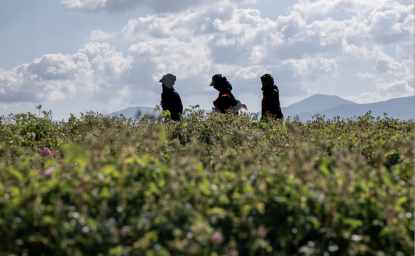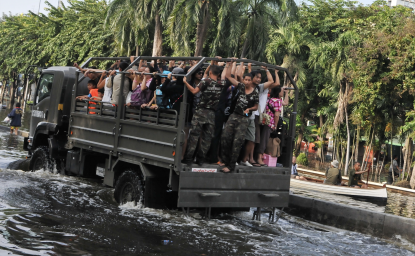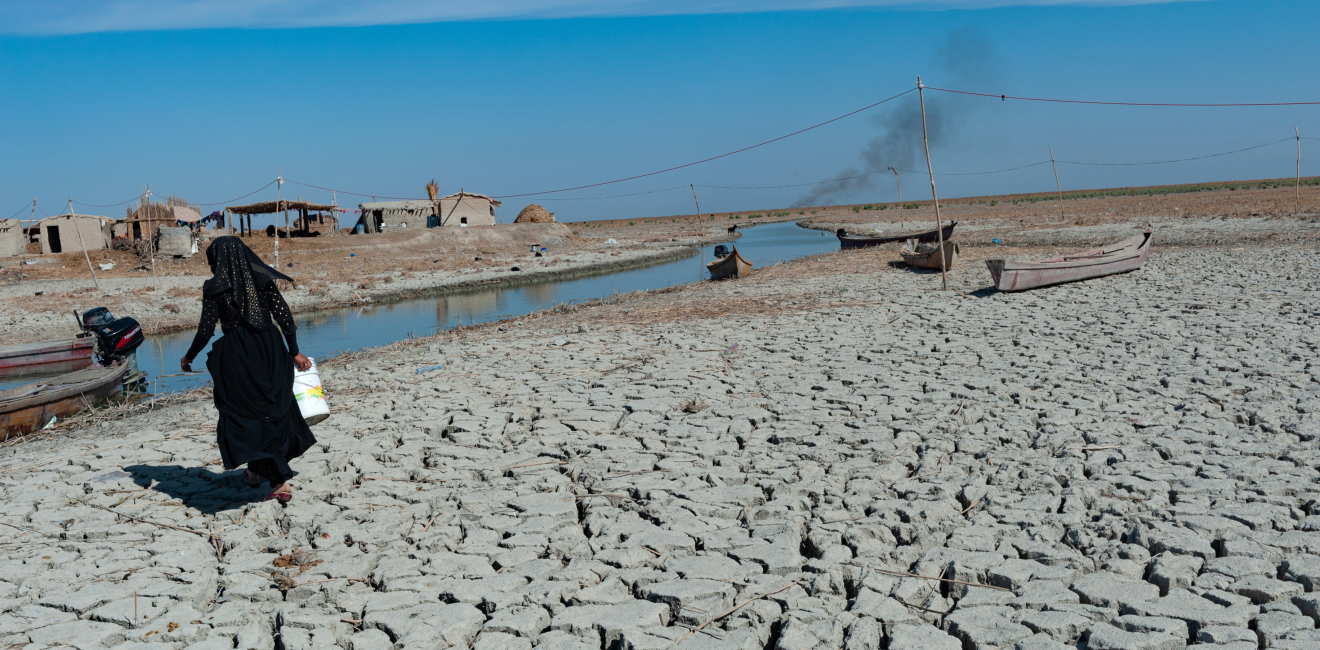The Middle East and North Africa (MENA) is among the world’s most water-stressed regions and is vulnerable to the effects of climate change. Concerns about the changing MENA climate include not only significant environmental and economic impacts, but also potentially negative implications for the region’s political stability and security.
In the 20th century, oil and gas – their ownership, value, transportation and consumption – affected MENA’s regional geopolitics to a great extent. In recent years, increasing pressure to decarbonize the energy sector and move towards renewable energy sources has the potential to re-shape this regional order. As such, the ways in which oil-rich countries transition towards other sources of income and diversify their economies are likely to produce significant political, social, and economic ramifications.
With hydrocarbons no longer the key variable in determining economic and political power, bi- and multi-lateral relations will likely be reconfigured.
Among the Arab states of the Gulf, there are signs of a growing political will to imagine what the region’s post-oil future will look like. In Saudi Arabia, for example, Crown Prince Mohammed bin Salman Al-Saud’s “Vision 2030” offers a blueprint for how the Kingdom plans to transition away from hydrocarbon dependence and encourage growth in other sectors of the economy. This is mirrored by similar future-oriented economic strategies in the United Arab Emirates (UAE). If oil-rich countries are seeking to use their wealth to invest in the non-hydro-carbon sector, MENA countries that are net importers of hydrocarbons will be afforded the opportunity to reduce their historic dependence on Gulf oil and gas. Morocco, for instance, is pursuing an ambitious renewable energy policy that aims to generate half of its electricity from renewable sources by 2030. With hydrocarbons no longer the key variable in determining economic and political power, bi- and multi-lateral relations will likely be reconfigured.
Even with national efforts to move away from hydrocarbon dependence in the region, climate change will have significant geopolitical implications in the region. This policy brief surveys three factors that are likely to become increasingly salient in the region: drought, rising sea-levels, and extreme heat.
Drought
Rural communities in MENA have long had to reckon with both cyclical and discrete periods of drought. Climate change, however, is expected to significantly impact the severity and frequency of these events, leading to serious challenges for food production in the region.
This will lead to domestic and international migration and an increased reliance on food imports, making the region particularly sensitive to fluctuations in global food supply chains and markets.
Heat, drought, and a decline in precipitation are expected to reduce the region’s arable land. This in turn will lead to domestic and international migration and an increased reliance on food imports, making the region particularly sensitive to fluctuations in global food supply chains and markets. A stark example of this is the current Ukraine-Russia crisis. Many countries in the region are highly dependent on Ukrainian and Russian wheat, including Yemen and Libya, which import 22 and 43 percent of their total wheat consumption from Ukraine, respectively. In addition, almost 85 percent of Egypt’s wheat imports came from Russia and Ukraine in 2020 and 2021. Disruptions to these supply chains and price increases may lead to significant social unrest; as attested to by the history of 20th century ‘bread riots’ in the region, including in Egypt in 1977 and Tunisia in 1983, as well as being a contributing factor to the 2010-11 Arab uprisings.
Water scarcity can also act as catalyst for conflict in the region – and can even be used as a weapon by political elites. As Marcus D. King and Rianna LeHane argue, in the future it is possible that both state and non-state actors will engage in ‘water weaponization’ by using water scarcity and pollution as a tool of war. For example, in 2014, the Islamic State (IS) captured the Tabqa, Tishrin, Mosul, and Fallujah dams on the Tigris-Euphrates river system, using the dams to both flood and starve populations living downstream. That being said, and as others have argued, the potential for water conflict has long been overstated in the literature, and has become a dominant narrative that obscures other dynamics as well as the potential for water issues to act as a catalyst for cooperation.
Rising Sea Levels
In a region where agriculture and economic activity is often centered on countries more temperate and littoral, sea level rise is also expected to significantly affect the region. Indeed, seven percent of the MENA’s total population lives in areas under five meters above sea level, including major urban metropolises such as Alexandria in Egypt and Basra in Iraq. Key regional industries, including tourism, fishing, agriculture and trade, are predicted to be affected by sea level rise and, like drought, will likely contribute to large-scale domestic and international migration.
Alexandria, the third-largest city in Egypt after Cairo and Giza, is one of several low-lying, coastal cities at serious risk of becoming submerged in the next three decades. “Much of the city is going to be inundated on a pretty regular basis,” said Dr. Jonathan Pershing, a veteran diplomat who served under four presidents and helped negotiate the 2015 Paris climate agreement. Such a development will slowly make the city uninhabitable to over 5 million residents and may result in people relocating inland to Cairo, an already heavily populated city of over 10 million. However, Dr. Pershing emphasized that even Cairo is subject to inundation and will likely suffer from “substantial flooding” that could lead to an enormous displacement crisis.
For Oman, sitting on the mouth of the Persian Gulf and facing three seas (the Arabian Sea, the Gulf of Oman, and the Arabian Gulf), severe tropical storms increasingly present the greatest danger and have already led to billions of dollars of damage. For instance, Cyclone Gonu caused an estimated $4 billion worth of damage in 2007 via flooding in Muscat and the disruption of Oman’s desalination water plants, which caused water shortages for days.
Extreme Heat
The MENA region is also expected to experience more regular extreme heat events in the 21st century. According to Pal and Eltahir, by the end of the century many population centers in the Middle East are likely to experience temperature levels that are intolerable to humans. Moreover, current temperature increases are leaving the region in acute danger of wildfires, with Lebanon experiencing multiple fires in the summer of 2019. "Between 1,200 and 1,500 hectares [4.6 and 5.7 square miles] were burned out in a single day…This is a very large number, as it [was] the equivalent of Lebanon’s annual rate of land lost in fires," said Sawsan Bou Fakhreddine, an adviser at the National Disaster Risk Reduction and Management Unit. In the last two years, hundreds of fires have swept across Lebanon as well as the coastal highland regions of neighboring Syria during summer heat waves, reaching residential areas and forcing hundreds to evacuate.
To understand the shape of conflict in the 21st century, geopolitical borders must be considered in conjunction with meteorological borders.
Combined with reduced rainfall, temperature increases are expected to move what Eyal Weizman has referred to as the ‘aridity line’, which marks the point at which annual rainfall drops below 200mm/year and makes rainfed arable agriculture impossible – the point at which the desert gives way to arable lands and the key threshold of 200mm of rain/year. This is not a static border but shifts over time, responding to both changes in the climate and human activity. Weizman goes on to note that Western drone strikes can, with remarkable accuracy, be mapped along this line as it moves through Lebanon, northern Yemen, Gaza and Iraq. Without wishing to fall into simple environmental determinism, Weizman argues that regions on the front line of the climate crisis are susceptible to conflict and violence. For Weizman, to understand the shape of conflict in the 21st century, geopolitical borders must be considered in conjunction with meteorological borders.
Conclusion
Disaggregating the multiple effects of climate change and considering their social, economic and political ramifications is the first step in designing policy that can mitigate climate change’s worst effects. It also allows us to forecast the ways in which climate change may affect regional dynamics and the restructuring the MENA’s geopolitical map. As such, it is paramount that future policy treats climate change as a dynamic variable that will transform the region’s security, economic and development models. The policy community – especially in relation to the MENA – has tended to downplay climate change or consider it an isolated variable that does not significantly alter the dominant frameworks through which we view the region. Such approaches fundamentally underestimate the challenges climate change poses and its potential to reorder the region’s geopolitics and security regimes.
Considering the challenges outlined above, four, broad policy strategies need to be pursued to lessen the effects of climate change. First, MENA governments should invest in renewable energy sources, including solar, wind and tidal energy, which should shift occur alongside a move away from highly centralized energy production models, empowering small private sector actors to participate in energy production.
Agricultural strategies should be resituated in local knowledges of water management, climate and soil, then combined with modern technologies to better support private production at the local level.
Second, the agriculture sector must update its practices to deal with increased climate variability and its effects on land and water resources. The 20th century saw MENA agricultural policy move towards global industrial agriculture methods: large-scale, capital-intensive, single crop production propped up by government incentives and subsidies. Instead, agricultural strategies should be resituated in local knowledges of water management, climate and soil, then combined with modern technologies to better support private production at the local level.
Third, MENA’s hydrological and energy infrastructures must be viewed as a combined system. As climate change changes the flow of surface and increases land water evaporation, management of the region’s hydrological and energy infrastructures must be adjust to fluctuating supply and demand pressures, and enable more efficient and equitable distribution of water. For example, the region’s many dams are dependent on reliable water supplies for energy generation capacity but, in turn, affect downstream agricultural water supplies.
Finally, there needs to be greater political will for bi- and multi-lateral climate change mitigation and adaptation policy. As this brief demonstrates, climate change does not follow national borders and thus its response requires trans-national approaches that are alert to the uneven effects of climate change.
The views expressed in these articles are those of the author and do not reflect an official position of the Wilson Center.
Author

Journalist

Middle East Program
The Wilson Center’s Middle East Program serves as a crucial resource for the policymaking community and beyond, providing analyses and research that helps inform US foreign policymaking, stimulates public debate, and expands knowledge about issues in the wider Middle East and North Africa (MENA) region. Read more

Explore More
Browse Insights & Analysis
Can Climate-Resilient Agriculture Become an Engine for Syria’s Post-Conflict Recovery?

ECSP Weekly Watch | March 10 – 14

ECSP Weekly Watch | February 17 – 21

